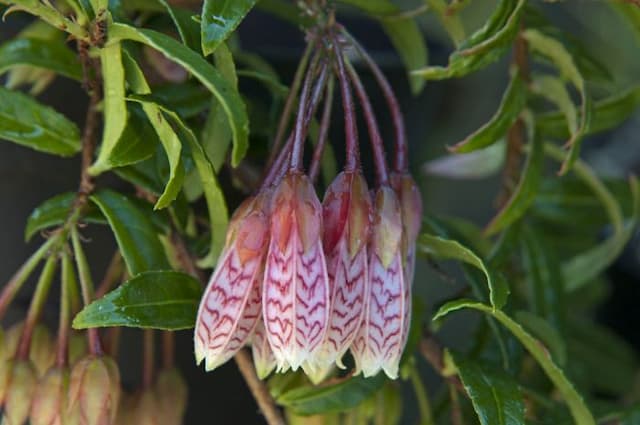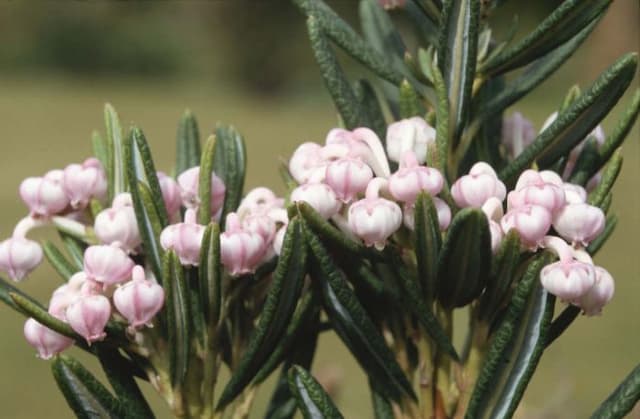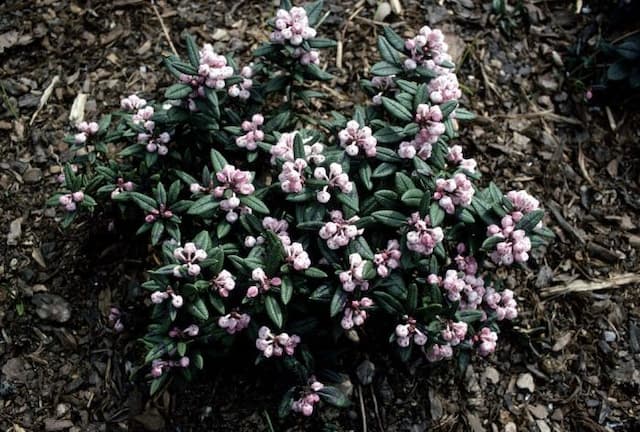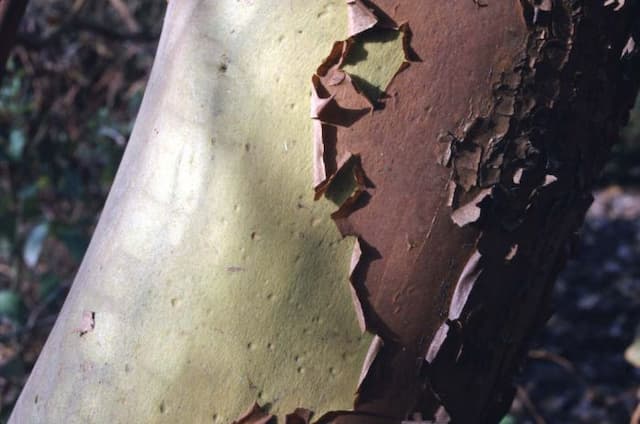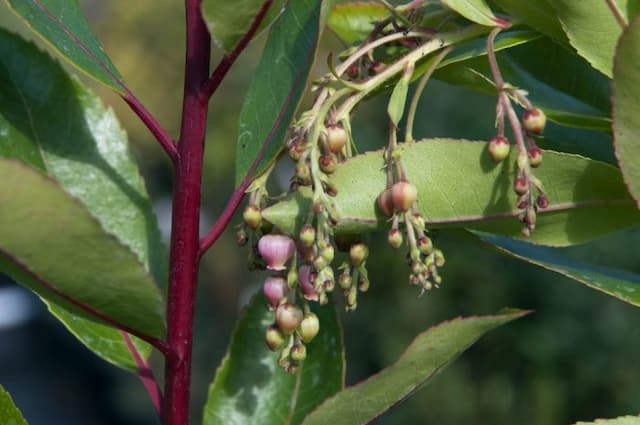Bauers Erica Erica bauera
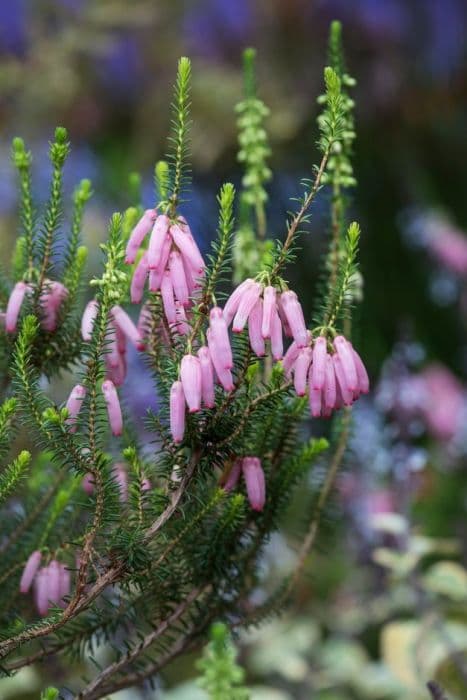
ABOUT
Erica bauera, also known as bauera, is a charming plant characterized by its evergreen nature and bushy appearance. Its foliage tends to be dense, with small, needle-like leaves that cover the slender, branching stems. The leaves are often arranged in whorls, tightly packed around the stem, creating a textured look. The bauera flaunts an abundance of bell-shaped flowers, which are a delight to observe. These blooms are typically pink, although they can also be found in shades of red as well as white. The flowers usually have a delicate, frilly appearance, with the petals slightly recurved at the edges, giving them a soft, ruffled look. These petals are arranged in a radial symmetry around the center of the flower, which is smaller in comparison to the overall bloom. The blossoms of the bauera are not only a visual treat but may also attract a variety of pollinators to the garden, such as bees and butterflies, adding to the dynamic nature of this plant. Overall, the bauera presents itself as a charming and decorative plant that contributes a splash of color and texture to the landscape.
About this plant
 Names
NamesFamily
Ericaceae.
Synonyms
Bauera's Heath, Bristly Heath, Button Heath, Bauera.
Common names
Erica baueri, Erica grandiflora.
 Toxicity
ToxicityTo humans
Erica bauera, commonly known as Bauera, does not have a well-documented profile regarding its toxicity to humans. There is limited information available regarding its potential poisonous effects if ingested. As with many plants, it is advisable to avoid consumption unless there is clear evidence that the plant is safe to eat. If you suspect poisoning from any plant, including Bauera, it is important to seek medical attention immediately. Symptoms of plant poisoning can vary but may include nausea, vomiting, diarrhea, abdominal pain, and more severe reactions such as difficulty breathing or altered heart rate depending on the specific toxins involved.
To pets
Bauera, the common name for Erica bauera, has no specific documented toxicity to pets in the general literature. However, it is always best to prevent pets from consuming plants that are not known to be safe. If a pet ingests Bauera and exhibits symptoms such as vomiting, diarrhea, lethargy, or any other concerning signs, it is important to consult with a veterinarian promptly. Always keep an eye on your pets and prevent them from ingesting plants unless you are certain they are non-toxic.
 Characteristics
CharacteristicsLife cycle
Perennials
Foliage type
Evergreen
Color of leaves
Green
Flower color
Varies
Height
1-2 feet (0.3-0.6 meters)
Spread
1-2 feet (0.3-0.6 meters)
Plant type
Shrub
Hardiness zones
9
Native area
South Africa
Benefits
 General Benefits
General Benefits- Aesthetic Appeal: Erica bauera, commonly known as the Bauera, adds visual interest to gardens with its delicate flowers and fine foliage.
- Wildlife Attractant: It attracts pollinators such as bees and butterflies, which are essential for the pollination of many plants.
- Drought Resistance: Once established, it is quite drought-tolerant, making it suitable for xeriscaping and water-efficient gardens.
- Soil Erosion Control: Its root system helps stabilize soil, making it a good choice for slopes or areas prone to erosion.
- Low Maintenance: Bauera is generally hardy and requires minimal care once established, suitable for low-maintenance landscapes.
- Versatility: It can be used in a variety of garden styles, including rock gardens, borders, and as groundcover.
 Medical Properties
Medical PropertiesThis plant is not used for medical purposes.
 Air-purifying Qualities
Air-purifying QualitiesThis plant is not specifically known for air purifying qualities.
 Other Uses
Other Uses- Floral Arrangements: Erica bauera, commonly known as Heath, is often used in floral arrangements for its petite flowers and long-lasting qualities.
- Environmental Indicators: Erica bauera can serve as an indicator of soil type and condition, as it tends to grow well in acidic and nutrient-poor soils.
- Garden Borders: Heath is frequently planted in garden borders for its compact growth habit and the color it adds throughout the year.
- Thematic Gardening: It is used in themed gardens such as fairy or miniature gardens due to its small scale and delicate appearance.
- Erosion Control: Erica bauera can be planted on slopes or banks to help prevent soil erosion because of its dense root system.
- Habitat Creation: The plant provides habitat and is a food source for various species of butterflies and other insects.
- Dried Crafts: Dried Heath flowers are used in crafting, for example in potpourri mixes, due to their structure and fragrance.
- Winter Gardens: This plant is valued for its winter flowering, bringing color to gardens when most other plants are dormant.
- Photography Prop: Because of its picturesque appearance, Heath is often used as a prop or background in plant and garden photography.
- Cultural Symbolism: In certain cultures, Erica bauera may be used as a symbol in rituals or ceremonies tied to the land and seasons.
Interesting Facts
 Feng Shui
Feng ShuiThe plant name Erica bauera, commonly known as heath, is not traditionally used in Feng Shui practice.
 Zodiac Sign Compitability
Zodiac Sign CompitabilityThe plant name Erica bauera, commonly known as heath, is not used in astrology practice.
 Plant Symbolism
Plant Symbolism- Endurance: Erica plants, in general, are known for their hardiness and ability to thrive in challenging conditions, symbolizing the ability to endure life's hardships.
- Protection: Some cultures believe ericas (heaths) provide protection, representing a safeguard against negative influences.
- Good fortune: In certain traditions, ericas are thought to bring good fortune, especially when given as a gift.
- Isolation: As a plant often found in solitary places like moors and highlands, it can symbolize solitude or self-reliance.
- Admiration: The delicate appearance of Erica flowers may represent admiration for beauty and finding joy in the small things in life.
 Water
WaterThe most common name for Erica bauera is Bauera. Bauera plants prefer consistently moist soil, but it's important not to overwater and cause waterlogging. Water your Bauera with approximately 1 gallon of water per week, ensuring an even distribution across the soil. During hotter seasons or if the plant is in full sun, the frequency may need to increase to maintain consistent moisture. Conversely, during winter or in cooler climates, water less frequently to match the plant's reduced water needs, perhaps scaling back to every other week.
 Light
LightFor Bauera plants, the best light conditions are bright, indirect sunlight. A spot that receives diffused light for most of the day, such as near a south-facing window with sheer curtains or an east/west-facing window, would be ideal. Avoid direct, harsh sunlight especially in the hot afternoons, as it can scorch the delicate foliage of the Bauera.
 Temperature
TemperatureBauera plants thrive best at temperatures between 50 to 70 degrees Fahrenheit. They can withstand minimum temperatures down to about 30 degrees Fahrenheit for short periods, but frost can damage the plant. Maximum temperature tolerance is around 80 degrees Fahrenheit before the plant may begin to show signs of stress. Always try to keep Bauera in their ideal temperature range for optimal health and flowering.
 Pruning
PruningBauera, commonly known as Bauera, benefits from pruning to maintain its shape, encourage bushier growth, and remove any dead or diseased stems. The best time to prune is in late winter or early spring before new growth begins. Prune lightly, removing up to a third of the plant's size, and cut just above a leaf node or a branching point. Regular pruning, done annually, will keep your Bauera looking neat and healthy.
 Cleaning
CleaningAs needed
 Soil
SoilThe best soil mix for Erica (Heath) should be well-drained and acidic with a pH between 4.5 to 5.5. A mixture of peat moss, sand, and loamy soil in equal parts is ideal for optimal growth.
 Repotting
RepottingErica (Heath) should be repotted every 2 to 3 years to replenish nutrients and prevent root bound conditions. Spring is the best time for repotting this plant.
 Humidity & Misting
Humidity & MistingErica (Heath) prefers moderate to high humidity levels, around 50% to 70%, for optimal growth. Avoid placing it in very dry environments.
 Suitable locations
Suitable locationsIndoor
Place Erica (Heath) in bright, indirect light and keep the soil slightly moist.
Outdoor
Plant Erica (Heath) in partial shade with acidic, well-draining soil.
Hardiness zone
7-9 USDA
 Life cycle
Life cycleErica bauera, commonly known as Bauera, begins its life cycle with seed germination, triggered by suitable environmental conditions like moisture and temperature. The seeds grow into seedlings, developing a root system and shoots with juvenile leaves. As the plant matures, it enters a vegetative growth phase, during which stems elongate, and foliage expands, establishing the plant's structure. Bauera then reaches the reproductive stage, where it produces distinctive flowers that attract pollinators for sexual reproduction. Following pollination and fertilization, the plant sets fruit, which contains seeds for the next generation. Eventually, as the plant ages and environmental conditions become unfavorable, it enters senescence, concluding its life cycle with death and decay, thereby returning nutrients to the soil.
 Propogation
PropogationPropogation time
Spring-Early Summer
The most popular method of propagation for the Erica bauera, commonly known as the Bauera, is through semi-hardwood cuttings. This is generally done in the late summer. Cuttings should be about 4 to 6 inches (10 to 15 centimeters) in length, with several leaves left at the tip. The bottom end of the cutting is then dipped in rooting hormone before being placed in a soil mix that has good drainage. The soil should be kept moist but not waterlogged, and the cuttings should be placed in a location with indirect light. In a few weeks, the cuttings will start developing roots, after which they can be transplanted into individual pots or into the ground, depending on the climate and the gardener's preference.
